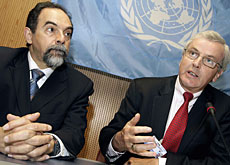Swiss send aid and experts to Peru

Swiss organisations are providing emergency aid and have launched appeals for victims of Wednesday's 8.0-magnitude earthquake in Peru.
While Swiss experts evaluate the situation and help coordinate aid in the devastated region, the Swiss Red Cross and Swiss Catholic charity Caritas have each sent SFr50,000 ($41,500) to go towards emergency aid.
Also on Friday the Geneva-based International Federation of Red Cross and Red Crescent Societies issued a preliminary emergency appeal for SFr1.6 million to support the Peruvian Red Cross and Red Crescent.
The funds will be used to supply some 20,000 people (4,000 families) with emergency items including tents, blankets, jerrycans, clothes, bedding and plastic sheeting.
“Immediate needs for the survivors include shelter – it’s winter now in Peru, and people need to be protected from the cold. They also need access to clean water,” said Peter Rees, the federation’s acting deputy director of disaster management, in Geneva.
“The funds will also finance vital psychological support to help survivors overcome the trauma of the catastrophe.”
On Friday survivors desperate for food and water ransacked a public market, while others looted a refrigerated trailer and blocked aid trucks on the Pan-American highway, prompting Peru’s president to appeal for calm.
Aid finally reached the disaster zone after about 36 hours without much help, but hopes of finding more survivors diminished.
At least 510 people have died and 1,500 have been wounded, the United Nations said on Friday, quoting national and local authorities. About 17,000 houses have been destroyed.
It’s estimated that the town of Pisco, with a population of just over 54,000 people, has suffered around 70 per cent destruction of its infrastructure.
Roads have been very severely damaged and telecommunications remain very difficult. All health centres and hospitals have been put on maximum alert, all doctors have been requested to make themselves available and all health services for the injured are free of charge.
Aid specialists
The Swiss Agency for Development and Cooperation (SDC) said a first team of local aid specialists had travelled to the central coastal region of Peru immediately after the tremor struck on Wednesday night local time.
A second group of four SDC staff flew to Peru on Friday, intending to arrive at the most-seriously affected towns of Pisco and Ica on Saturday.
But there were no plans to send Swiss rescuers at the moment because the Peruvian government had not asked for international aid, said SDC spokesman Jean-Philippe Jutzi.
Peru has been a priority country of Swiss aid for more than four decades. The SDC and other Swiss government agencies are involved in development cooperation and humanitarian assistance. They also promote good governance and sustainable economic growth.
The UN has released $1 million (SFr1.2 million) to help those affected, while the Peruvian government called for meetings with the donor community in Lima to mobilise additional resources.
Hospitals overwhelmed
The quake struck late on Wednesday and many of its victims were poor, killed when their flimsy mud-brick homes caved in. Hospitals and morgues were overwhelmed, forcing residents to lay bodies out on city streets.
The UN said the situation was worst in the cities of Canete, Chincha and Pisco – about 300 kilometres south of the capital Lima – although other areas such as Nazca and Palpa were inaccessible.
On Friday an aftershock of 6.0 magnitude rattled Peruvians, sowing panic in the hardest-hit towns where volunteers were trying to help emergency crews find the living and treat the injured.
President Alan Garcia visited the quake-hit areas on Thursday and declared three days of national mourning.
All flights from the international airport in Lima have been temporarily suspended. Tsunami warnings and advisories were initially issued along the coast of Central and South America, as well as Hawaii, but were later cancelled.
swissinfo with agencies
Peru was the first priority country for Swiss development cooperation in Latin America.
Last year humanitarian and technical aid to Peru totalled SFr15.9 million ($13.09 million). This year it is expected to drop to SFr13.4 million.
Development aid is focusing on the three mountain areas of Cajamarca, Cusco and Apurimac.
Scientists said the quake was a “megathrust”, a type of earthquake similar to the catastrophic Indian Ocean quake in 2004 that generated deadly tsunami waves.
In general, quakes measuring 8 on the Richter scale are capable of causing tremendous damage. Quakes of magnitude 2.5-3 are the smallest generally felt, and every increase of one number on the magnitude scale means that the quake’s magnitude is 10 times as great.
The quake occurred in one of the most seismically active regions in the world at the boundary where the Nazca and South American tectonic plates meet. The plates are moving together at a rate of 7.5cm a year.
Wednesday’s quake was one of the worst natural disasters to hit the South American country during the last century. In 1970, an earthquake killed an estimated 50,000 Peruvians in catastrophic avalanches of ice and mud that buried the town of Yungay.
The largest recorded earthquake was the Great Chilean Earthquake of May 22, 1960, which had a magnitude of 9.5.

In compliance with the JTI standards
More: SWI swissinfo.ch certified by the Journalism Trust Initiative











You can find an overview of ongoing debates with our journalists here . Please join us!
If you want to start a conversation about a topic raised in this article or want to report factual errors, email us at english@swissinfo.ch.